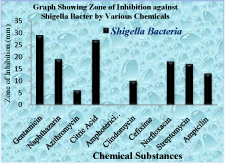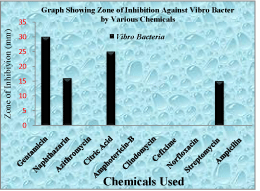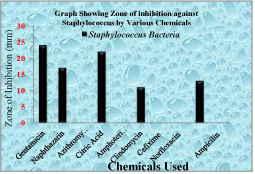
Research Article
J Bacteriol Mycol. 2017; 4(3): 1051.
Evaluation of Antimicrobial Activity of Various Chemicals on Isolated Chicken and Mutton Spoilage Microorganisms
Ahmad Mir B¹, Amin Mir M²*, Singh D1 and Rao Z¹
¹Department of Microbiology and Zoology, Uttaranchal College of Biomedical Sciences and Hospital, India
²Research Scholar at Uttarakhand Technical University, India
*Corresponding author: Mohd Amin Mir, Research Scholar at Uttarakhand Technical University, Dehradun, India
Received: April 28, 2017; Accepted: May 22, 2017; Published: May 29, 2017
Abstract
The study was carried out on the isolation of various micro-organisms, in which various samples of chicken and mutton were collected from different locations of the Dehradun. The process of slaughtering of the chicken and mutton as per the survey was of two types- viz, Jatka and Halal. The isolated microorganisms from the chicken samples of Jatka type include- Vibrio, Enterobacter Species, Clostridium, E.coli, Shigella, where as the micro-organisms isolated from the chicken samples of Halal type include only Enterobacter Species, Clostridium and E.coli. The micro-organisms isolated from the mutton sample of Jatka type include, Shigella, E.coli, Vibrio, staphylococcus, and the microorganisms isolated from the mutton samples of Halal type include only E.coli, Vibrio, and staphylococcus. The micro-organisms have been isolated and identified by various biochemical tests. The isolated micro-organisms have been then testified for antimicrobial susceptibility test against various chemical substances which include, Gentamicin, Naphthazarin, Azithromycin, Citric Acid, Amphotericin-B, Clindamycin, Cefixime, Norfloxacin, Streptomycin, Ampicillin. Among the various used chemical substances, Gentamicin have been found effective in inhabiting the growth of all the isolated micro-organisms, followed by Norfloxacin, Streptomycin, Ampicillin, Azithromycin, Citric Acid. Least antimicrobial activity was observed for Naphthazarin, Amphotericin-B, Clindamycin, and Cefixime. Among the isolated micro-organisms shigella species was found to be less proned against the applied anti-microbial drugs, and the most susceptible micro-organism among the isolated micro-organisms includes E.coli. Also from the collected chicken and mutton samples the samples of Halal type have been to be less effective against the growth of micro-organisms as compared to the Jatka type samples, which could be due to different procedure of slaughtering technique.
Keywords: Chicken and mutton samples; Anti-microbial activity; Halal and Jatka; Vibrio; Enterobacter Species; Clostridium; E.coli; Shigella; Staphylococcus
Introduction
Microorganisms can be used to transform raw foods into fermented delights, including yoghurt, cheese, sausages, Tempeh, pickles, wine, beers and other alcoholic products. On the other hand, foods also can act as a reservoir for disease transmission, and thus detection and control of pathogens and spoilage organisms are important areas of food microbiology. During the entire sequence of food handling from the producer to the final consumer, microorganisms can affect food quality and human health.
This study briefly summarizes current knowledge on the biological implications of biogenic amines on human health and collects data on the factors affecting their formation in meat and fermented meat products by Joanna Stadnik, Zbigniew J. Dolatowski [1]. George-John E. Nychas, Panos N. Skandamis, Chrysoula C. Tassou, Konstantinos P. Koutsoumanis [2] studied on meat spoilage during distribution can be considered as an ecological phenomenon that encompasses the changes of the available substrata (e.g., low molecular compounds), during the prevailing of a particular microbial association, the socalled Specific Spoilage Organisms (SSO).
Microbial contamination of poultry carcasses can be influenced by many factors during transport and slaughtering. The study carried out by Irena Svobodová, Gabriela Borilová [3] evaluated the impact of four processing steps (plucking, evisceration, washing and chilling) on the Total Viable Counts (TVC), counts of Escherichia coli, Salmonella spp. and Listeria spp. incidence on broiler carcasses. Food borne illness is a major public health concern. The largest number of food borne illness cases attributed to poultry and poultry products are caused by paratyphoid serotypes of Salmonella and by Campylobacter jejuni as studied by P.L. White A.R. Baker & W.O. James [4]. Consumption of meat is continuously increasing worldwide. The annual per capita consumption increased from 10kg in the 1960s to 26kg in 2000 and will reach 37kg by the year 2030 as per the reports by Joanna Stadnik, Zbigniew J. Dolatowski, [5]. On the other hand, a significant portion of meat and meat products are spoiled every year. Kantor et al. (1997) reported that approximately 3.5 billion kg of poultry and meat were wasted at the consumer, retailer and foodservice levels which have a substantial economic and environmental impact.
Material and Methods for Antimicrobial Analysis
The antimicrobial analyses of various “Chicken and Mutton” samples were carried out at Uttaranchal College of Biomedical Sciences and Hospital, Dehradun.
Microbial world is of great importance in the present world. They are beneficial in various ways to humans, not only they help to maintain the environment clean, but also they furnish various types of antibiotics which are useful against various diseases. So this microbial analysis was carried out. All the chemicals used were of analytical grade.
Different samples of chicken and mutton were collected from the local shops at D. L. Road and Sahastradhara crossing, Dehradun then leaved all of these samples for 4 days for complete spoilage.
Identification methods
All the bacterial colonies were identified by Gram’s staining method as they are Gram -ve or Gram +ve & several biochemical characterization methods.
Litmus milk test, Gelatin Agar test and Urea agar media were used to determine the load of viable cells followed by several biochemical tests for this purpose.
Observations
Identification of Bacterial strains: So far our observation is taken into consideration the following types of microorganisms have been isolated from the meat and chicken samples and are mention in the following tables (Table 1-8).
S. No
Name of Bacteria Isolated
Chicken Sample
Mutton Sample
Halal
Jatka
Halal
Jatka
Shigella
------------------
---------------
Shigella
Enterobacter Species
Enterobacter Species
---------------
---------------
Clostridium
Clostridium
----------------
----------------
E.coli
E.coli
E.coli
E.coli
Vibrio
-----------
Vibrio
Vibrio
-----------
-----------
staphylococcus
Staphylococcus
Table 1: Showing various bacterial strains isolated from the chicken and mutton samples.
S. No
Strain Used
Chemical Used
Zone of Inhibition (mm)
1
Shigella
Gentamicin
29
2
Shigella
Naphthazarin
19
3
Shigella
Azithromycin
6
4
Shigella
Citric Acid
27
5
Shigella
Amphotericin-B
Nil
6
Shigella
Clindamycin
10
7
Shigella
Cefixime
Nil
8
Shigella
Norfloxacin
18
9
Shigella
Streptomycin
17
10
Shigella
Ampicillin
13
Table 2: Showing zone of inhibition against Shigella bacteria.
S. No
Strain Used
Chemical Used
Zone of Inhibition (mm)
1
E.coli
Gentamicin
28
2
E.coli
Naphthazarin
15
3
E.coli
Azithromycin
06
4
E.coli
Citric Acid
26
5
E.coli
Amphotericin-B
Nil
6
E.coli
Clindamycin
Nil
7
E.coli
Cefixime
Nil
8
E.coli
Norfloxacin
18
9
E.coli
Streptomycin
17
10
E.coli
Ampicillin
13
Table 3: Showing zone of inhibition against E. coli bacteria.
S. No
Strain Used
Chemical Used
Zone of Inhibition (mm)
1
Vibrio
Gentamicin
30
2
Vibrio
Naphthazarin
16
3
Vibrio
Azithromycin
Nil
4
Vibrio
Citric Acid
25
5
Vibrio
Amphotericin-B
Nil
6
Vibrio
Clindamycin
Nil
7
Vibrio
Cefixime
Nil
8
Vibrio
Norfloxacin
Nil
9
Vibrio
Streptomycin
15
10
Vibrio
Ampicillin
Nil
Table 4: Showing zone of inhibition against Vibrio bacteria.
S. No
Strain Used
Chemical Used
Zone of Inhibition (mm)
1
Enterobacter Species
Gentamicin
27
2
Enterobacter Species
Naphthazarin
20
3
Enterobacter Species
Azithromycin
Nil
4
Enterobacter Species
Citric Acid
24
5
Enterobacter Species
Amphotericin-B
Nil
6
Enterobacter Species
Clindamycin
13
7
Enterobacter Species
Cefixime
Nil
8
Enterobacter Species
Norfloxacin
Nil
9
Enterobacter Species
Streptomycin
15
10
Enterobacter Species
Ampicillin
Nil
Table 5: Showing zone of inhibition against Enterobacter Species bacteria.
S. No
Strain Used
Chemical Used
Zone of Inhibition (mm)
1
Clostridium
Gentamicin
27
2
Clostridium
Naphthazarin
17
3
Clostridium
Azithromycin
14
4
Clostridium
Citric Acid
25
5
Clostridium
Amphotericin-B
Nil
6
Clostridium
Clindomycin
19
7
Clostridium
Cefixime
Nil
8
Clostridium
Norfloxacin
20
9
Clostridium
Streptomycin
12
10
Clostridium
Ampicilin
10
Table 6: Showing zone of inhibition against clostridium bacteria.
S. No
Strain Used
Chemical Used
Zone of Inhibition (mm)
1
Staphylococcus
Gentamicin
24
2
Staphylococcus
Naphthazarin
17
3
Staphylococcus
Azithromycin
Nil
4
Staphylococcus
Citric Acid
22
5
Staphylococcus
Amphotericin-B
Nil
6
Staphylococcus
Clindamycin
11
7
Staphylococcus
Cefixime
Nil
8
Staphylococcus
Norfloxacin
Nil
9
Staphylococcus
Streptomycin
13
10
Staphylococcus
Ampicillin
Nil
Table 7: Showing zone of inhibition against Staphylococcus bacteria.
S. No
Strain Used
Chemical Used
Zone of Inhibition (mm)
1
Salmonella
Gentamicin
27
2
Salmonella
Naphthazarin
16
3
Salmonella
Azithromycin
Nil
4
Salmonella
Citric Acid
27
5
Salmonella
Amphotericin-B
Nil
6
Salmonella
Clindamycin
Nil
7
Salmonella
Cefixime
Nil
8
Salmonella
Norfloxacin
Nil
9
Salmonella
Streptomycin
15
10
Salmonella
Ampicillin
Nil
Table 8: Showing zone of inhibition against Salmonella bacteria.
Antimicrobial Susceptibility Testing: Antimicrobial activity of various chemical substances against various isolated bacterial strains from chicken and mutt on samples (Graph 1-7).

Figure 1: Showing Effect of chemicals on E.coli bacteria.

Figure 2: Showing Effect of chemicals on E.coli bacteria.

Figure 3: Showing Effect of chemicals on Vibrio bacteria.

Figure 4: Showing Effect of chemicals on Enterobacter Species bacteria.

Figure 5: Showing Effect of chemicals on Clostridium bacteria.

Figure 6: Showing Effect of chemicals on Staphylococcus bacteria.

Figure 7: Showing Effect of chemicals on Staphylococcus bacteria.
Results and Discussion
Altogether 06 bacterial isolates were obtained from chicken sample and 04 isolates from mutton sample. The bacterial isolates were screened for their thermo-tolerance property in different temperatures starting from 50°C to 90°C.
The bacterium Staphylococcus species is a spherical bacterium (coccus) which on microscopic examination appears singly, in pairs, or bunched, grape-like clusters. They are Gram-positive, facultative anaerobes, but grow rapidly under aerobic conditions and were characterized by morphological observation and biochemical tests. Salmonella is a rod-shaped, Gram negative, non-sporulating, facultative anaerobic motile bacterium. They are mesophiles with a growth temperature range of 5 to 46°C and optimum growth temperature of 35 to 37°C. Litmus milk test, Gelatin Agar test and Urea agar media viable cells followed by several biochemical tests lead to the identification of Salmonella. Shigella was identified as Gramnegative, non-motile, non-spore forming rod-shaped bacteria as per Litmus milk test, Gelatin Agar test and Urea agar media followed by several biochemical tests. The strains grow between 7 and 46°C, with an optimum at 37°C. Litmus milk test, Gelatin Agar test and Urea agar media followed by several biochemical tests identified E. coli as harmless, Gram negative, motile, non-sporulating; rod shaped facultative anaerobic bacterium. Vibrio bacterium as identified as Gram-negative, non-sporulating motile curved rods with an optimum temperature of 30°C to 37°C, but can grow over a temperature range of 5 and 42°C as per Gelatin Agar test and Urea agar media followed by several biochemical tests. The identification of Enterobacter bacteria was carried out by Gelatin Agar test and Urea agar media followed by several biochemical tests and had been identified as motile, rodshaped cells, some of which are encapsulated. Clostridium was identified as an anaerobic, Gram-positive, spore-forming rod that produces a potent neurotoxin by various tests like Gelatin Agar test and Urea agar media followed by several biochemical tests.
Preliminary Screening for the anti bacterial activity was performed using Agar Well diffusion method. The mentioned Chemical substances showed an excellent antibacterial activity against the bacteria Shigella, Enterobacter Species, Clostridium, E. coli, Vibrio, and Staphylococcus. As per the microbial susceptibility tests Gentamicin showed highest antibacterial activity against Shigella bacterium fallowed by citric acid, Naphthazarin, Norfloxacin, Streptomycin and less activity was observed for Azithromycin. Gentamicin showed highest antimicrobial activity against E.coli, followed by citric acid, Norfloxacin, Streptomycin and Naphthazarin. Least activity was observed by azithromycin antibiotic. For Vibrio bacterium, the highest zone of inhibition was showed by Gentamicin fallowed by citric acid, Naphthazarin and less activity was observed for streptomycin. Clindamycin, Azithromycin, Amphotericin-B, Cefixime, Norfloxacin, and Ampicillin showed no any activity against Vibrio Bacterium. Enterobacter species have no any effect upon the utilization of Azithromycin, Amphotericin-B, Cefixime, Norfloxacin, and Ampicillin. The concerned bacterium is adducted against these antibiotics. Gentamicin have a highest response against Enterobacter as per antimicrobial susceptibility is taken into consideration followed by citric acid, Naphthazarin and Clindamycin. Clostridium bacteria have no any effect against antibiotics like Cefixime, and Amphotericin-B. Ampicillin have less activity against Clostridium bacteria and highest antimicrobial susceptibility was observed for Gentamicin followed by citric acid Norfloxacin, Clindamycin, Naphthazarin, Azithromycin, Streptomycin. The Highest Zone of Inhibition was observed by Gentamicin against Staphylococcus, followed by Citric Acid, Naphthazarin, Streptomycin and Clindamycin. No any activity was observed by the use of Azithromycin, Amphotericin-B, Cefixime, Norfloxacin and Ampicillin antibiotics. Salmonella bacterium a strong bacteria and some antibiotics like Gentamicin, Naphthazarin and citric acid have some antimicrobial activity against salmonella. Rest of the used antibiotics like, Ampicillin, Norfloxacin, Cefixime, Amphotericin-B and azithromycin have no any activity against the salmonella bacterium.
Conclusion
From the above mention research it could be concluded that the spoiled chicken and mutton samples should not be consumed. Being rich in protein content the chicken and the mutton samples are frequently affected by various bacterial strains. Also from the collected chicken and mutton samples the samples of Halal type have been found to be less effective against the growth of micro-organisms as compared to the Jatka type samples, which could be due to different procedure of slaughtering technique. In case of Jatka the animal is being slaughtered at once and the blood gets coagulated within no time, but during the slaughtering process in which the animal is being slaughtered in a Halal way, makes whole blood to come out of the body of an animal. So as per this research it could be concluded that Halal type of flesh should be consumed than the Jatka type.
References
- Stadnik J, Dolatowski ZJ. “BIOGENIC AMINES IN MEAT AND FERMENTED MEAT PRODUCTS”. Acta Sci. Pol., Technol. Aliment. 2010; 9: 251-226.
- Nychas GJE, Skandamis PN. “Meat spoilage during distribution”. Meat Science. 2008; 78: 77-89.
- Svobodová I, Borilová G, Hulánková R, Steinhauserová I. “Microbiological quality of broiler carcasses during slaughter processing”. ACTA VET. BRNO. 2012; 81: 037-042.
- White PL, Baker AR, James WO. “Strategies to control Salmonella and Campylobacter in raw poultry products”. Rev. sci. tech. Off. int. Epiz. 1997; 16: 525-541.
- Stadnik J, Dolatowski ZJ. Biogenic amines in meat and fermented meat products. Acta Sci. Pol., Technol. Aliment. 2010; 9: 251-263.